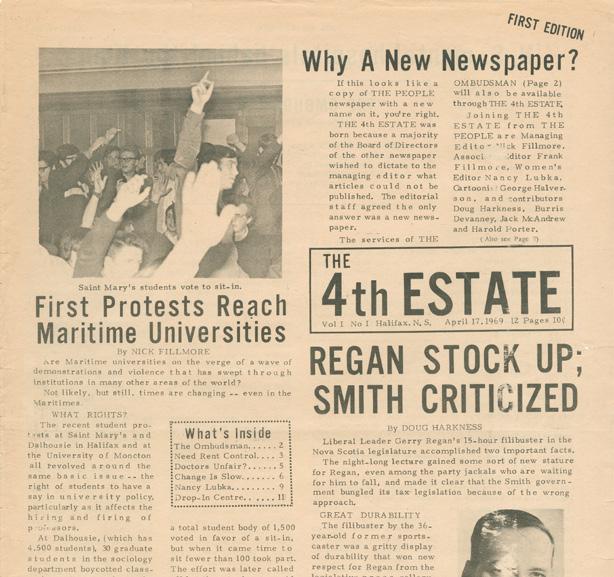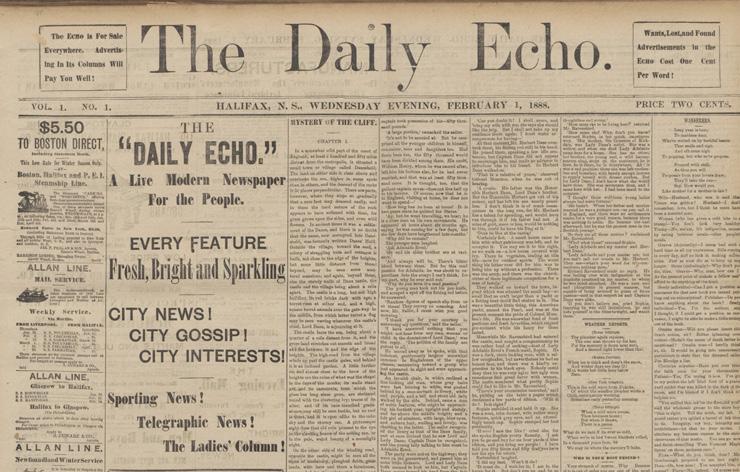
5 minute read
THE BACKSTORY
TURN THE PAGE
Not too long ago, newspapers were king in Halifax — looking back at a dramatic transformation
BY KATIE INGRAM
As the role of the newspaper continually changes in Halifax, one thing remains the same: there is always room for alternative news coverage.
From the mid-19th to the early 20th century, Halifax was home to five main papers: the Morning Chronicle and its afternoon counterpart the Daily Echo, the Halifax Herald and the Evening Mail, and The Acadian Recorder. Others came and went, including the Halifax Citizen, the Halifax Morning Sun, the Dartmouth Journal, and the Unionist and Halifax Journal, plus faith-based papers like the Church Guardian.
The big five newspapers were the kings of East Coast media for many years. For example, the morning-afternoon duos of the Herald and Mail and the Chronicle and the Echo each had circulations of about 10,000 in 1901.
The reason behind this success is twofold, explains historical author and journalist Dean Jobb.
“First, it was the the only mass media: no radio, and it would be decades before television, so that’s how people got their news,” he says. “The other ... underlying factor was, at the turn of the century — early 1900s — the press was still partisan. In major cities, you would have a Liberal newspaper and a Conservative newspaper going head-to-head, promoting their party’s interest.”
Political involvement in newspapers waned in the 20th century, giving more editorial freedom. “It was possible to have an independent paper,” says Jobb.
However, readership started declining around mid-century, amid competition from exciting new technology like radio and TV. (Sound familiar?) And by becoming nonpartisan, many lost the loyalty of their core audiences. By the mid-1900s, the Acadian Recorder no longer existed and the remaining four of the big five consolidated in 1949 to become the Chronicle Herald and the Mail-Star.
Jobb says that was a widespread trend after the Second World War, with many towns seeing once robust newspaper scenes consolidated to a single publisher.
Alternatives have come and gone, including the 4th Estate which lasted from 1969 to 1977, the Daily News from 1974 to 2008, and the still-publishing Coast.
“The trend towards one-newspaper towns meant a monopoly in newspapers, and that does attract competitors, if they see a chance,” says Jobb. “It can be both a feeling that there’s stories that need to be told or are under reported.”

1752
The Halifax Gazette releases its first issue and is the first newspaper in Canada. It became the Nova Scotia Royal Gazette in 1867 and is now a government paper.
1813

The Acadian Recorder is founded.
1823
The British Colonist, a tri-weekly paper, launches.
devenystamps.com
1824
The Novascotian, originally known as the Colonial Herald, releases its first issue. In 1827 Joseph Howe would purchase the paper. It would famously publish a letter in 1835 that would see Howe on trial for a libel, which he would win — a landmark victory for freedom of the press.
This timeline offers a snapshot of many of the newspapers serving Halifax over the years; it isn’t intended to be a comprehensive list.
1864
The Morning Chronicle releases its first issue. Its afternoon counterpart would be the Evening Mail.
1874
The British Colonist closes.
1874
The Morning Herald and Commercial Advertiser launches, eventually becoming the Halifax Herald. Its later afternoon counterpart would be the Daily Echo, forerunner of the Star.
1949
The Halifax Herald buys the Chronicle and Star, resulting in a morning edition called the Chronicle Herald and an afternoon one called the Mail-Star.
1930
After the death of owner C.C. Blackadar, the Acadian Recorder closes, relaunching as an afternoon paper in 1932.
1920s
The Novascotian, which became Nova Scotia’s Farm and Home Journal, shuts down.
1950
The Dartmouth Free Press is founded.
1969
The Fourth Estate, a newspaper that called itself a “second viewpoint” for Halifax, releases its first issue.
1974
The BedfordSackville Observer launches. It later became the Halifax Daily News.
1901
The Dartmouth Patriot is founded and the Atlantic Weekly ceases publication.
1893
The Atlantic Weekly, headquartered in Dartmouth, is founded.
January 1888
The Echo, previously known as the Citizen and Evening Chronicle, releases its first issue.
1977
The 4th Estate shuts down.
1982
The Dartmouth Free Press shuts down.
1993
The Dartmouth Patriot shuts down. 2004 The Mail-Star is discontinued.
2019
StarMetro shuts down.
2017
Transcontinental Publishing sells its Atlantic papers, both weeklies and dailies, to the Saltwire Network, the then-new parent company of the Chronicle Herald.
2008
Metro launches as the Daily News closes. A commuter newspaper with a mix of original journalism and syndicated content, Metro would eventually become StarMetro.


Left to right: Acadian Recorder, 16 January 1813, Volume 1 Number 1; The Daily Echo, February 1888, Volume 1 Number 1; The 4th Estate, 17 April 1969 Volume 1 Number 1 - Nova Scotia Archives



Nova Scotia Information Service Nova Scotia Archives no. NSIS 14945 Chronicle Herald

This space was used until 2008, when the Herald offices moved to Joseph Howe Drive. Herald / Evening Mail
William Dennis bought this former Halifax Herald office in 1900.
Acadian Recorder
The Acadian Recorder’s office was at this location from 1900 to its initial closure in 1930.
The Chronicle / Echo
In 1907, the Chronicle’s offices were at 85–93 Granville St. The Daily News
The offices of the Daily News when it shut down in 2008. Halifax Citizen
The Halifax Citizen’s offices, in 1876, were at 159 Hollis St. Halifax Citizen
In 1871 the Citizen was located in this area, at 25 Sackville St. Halifax Sun
In 1867, the Sun was located at the corner of Granville and
George streets. Halifax Sun
Before 1867, the Sun was at somewhere near 158 Hollis St. Halifax Herald
A 1926 city directory lists the Halifax Herald offices at 42–50 Sackville St.
The Chronicle
A 1926 directory lists the Chronicle (Chronicle Co. Ltd) at 85–93 Sackville St.
4th Estate
5211 Blowers St.
Novascotian
5140 Prince St. John Bushell’s Print Shop
Bushell was the publisher of the Halifax Gazette and likely published his newspaper at his print shop at the corner of
Grafton and Duke streets. Metro
Majority-owned by the publisher of the Toronto Star, Metro operated at 3260 Barrington St.








